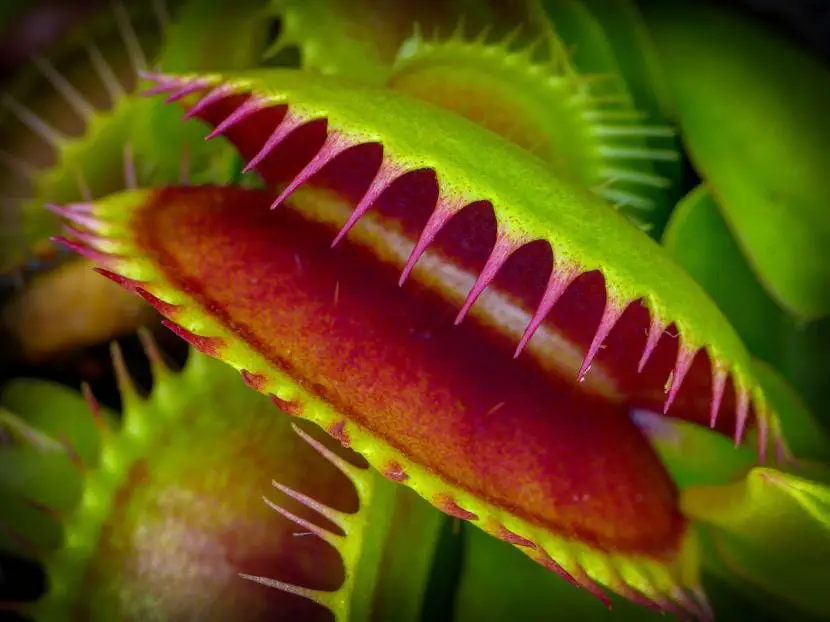
Dionaea muscipula
Carnivorous plants are a very special type of plant being. They have evolved in such a different way from the rest of the plants that we know that it is not surprising that today the number of collectors is only increasing.
But What are carnivorous plants exactly? What is it that attracts us so much attention?
What is a carnivorous plant?

sarracenia rubra
Carnivorous plants, also called insectivorous plants, are plants that obtain most of the nutrients they need through animals and protozoa that fall into their traps. And it is that, growing in such poor soil, such as swampy acid lands and rocky cliffs, they have had no choice but to transform their leaves into sophisticated traps. Traps that produce enzymes or have digestive bacteria capable of absorbing the bodies of the unfortunate who end up in them.
To date, around 630 species of carnivorous plants are known, distributed in 11 lineages. In addition, there are more than 300 protocarnivorous plants, that is, plants that show some characteristics of the former.
What types of traps do they have?
The different types of traps are:
Tweezers

The trap It consists of a modified leaf whose margins are clamped and inside two detector cilia (what we call “hairs”) on each side. When an insect is attracted to the nectar they produce, they land on them and, when it touches two cilia in a maximum time of five seconds, the trap closes automatically.
Examples: Dionaea and Aldrovanda are the only ones that have these types of traps.
Sticky hairs

Penguin ‘Sethos’
On the surface of the leaves are a series of sticky hairsat the end of which the plant secretes a viscous fluid with a scent similar to honey. When an insect lands on them, it can no longer escape.
Examples: Drosera, Pinguicula, Byblis, Drosophyllum, Pinguicula, among others.
Fall traps

darlingtonia californica
Known as wineskin plants, Its leaves were transformed into traps in the shape of a vase or cup at the bottom of which they have a watery liquid that drowns the insects that fall into them. These are attracted by the sweet aromas that carnivores produce on the edge of the traps.
Examples: Darlingtonia, Heliamphora, Nepenthes, Sarracenia, Cephalotus, and Brocchinia reducta.
Mechanical traps

Utricularia minor
On each stem they have numerous traps that look like tiny globes. Each of those traps have a very small hatch. If an insect passes by, it will brush some bristles that are attached to the hatch, which will open and the trap will absorb the water with the animal inwards. The hatch will then close.
Example: Utricularia is the only genus that has these types of traps.
Lobster-pot traps

Genlisea filiformis
These plants have a Y-shaped blade, allowing protozoa to enter but not exit. This is covered with hairs that point downwards, which forces them to move in a particular way, which is why they are forced to move towards the stomach, which is in the upper arm of the Y, where they will be digested.
Examples: Genlisea is the only genus that has these traps.
Trap combination

Sundew glanduligera
It is a plant that combines the characteristics of the pincer traps and their sticky hair traps.
Examples: we can only see it in the Sundew glanduligera.
What care do these plants need?

Cephalotus follicularis
If you would like to have a carnivorous plant, we recommend providing it with the following care:
- Location:
- Exterior: the vast majority in semi-shade. Only the Sarracenia and the Dionaea can be in full sun (be careful, you have to get used to them little by little, otherwise they could easily burn).
- Indoor: in a room with plenty of natural light.
- Flower pot: use a plastic one.
- Substratum: blond peat mixed with perlite in equal parts is the most common.
- Irrigation: every 1-2 days in summer and somewhat more spaced the rest of the year. Use rainwater, osmosis or distilled water.
- Transplant: every 2-3 years in late winter. The Sarracenia every 1-2 years.
- Hibernation: Drosophyllum, Sarracenia, Heliamphora, Darlingtonia, Dionaea and others need a cool winter, with mild frosts down to -1º or -2ºC.
- Rusticity: It will depend on the species, but in general they do not withstand temperatures below 0 degrees.
If you want to see how to plant them in pots, take a look at our video:
What did you think of this topic?

2 thoughts on “What are the characteristics and care of carnivorous plants?”